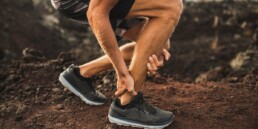What is lymphedema?
Lymphedema is swelling caused by an abnormal accumulation of lymphatic fluid in the soft tissues of a body part, often the arms or legs. Lymphatic fluid, also called lymph, circulates throughout the body like blood. It carries white blood cells, antibodies, and nutrients. Lymph is filtered through lymph nodes, primarily located in the armpits, neck, and groin.
Lymphedema typically appears in people who have undergone surgery, especially when lymph nodes have been removed. It can lead to significant swelling and a feeling of pressure in the affected limbs. The risk of developing it increases with the number of lymph nodes affected.
The two types of lymphedema
Primary
Present from birth or appearing later for unknown reasons. This type of lymphedema, which is relatively rare, is caused by an abnormality in the lymphatic system.
Secondary
The most common type occurs when the lymphatic system has been damaged due to trauma, surgery, radiation therapy, or certain diseases affecting lymphatic circulation. It generally appears in the first few years after cancer treatment.
Main causes of lymphedema
- Surgery in which lymph nodes are removed (lymph node dissection);
- Infection or inflammation that can damage the lymphatic vessels;
- Cancer that has spread to the lymph nodes (metastasis);
- Underlying diseases affecting lymphatic circulation;
- Radiation therapy to the lymph nodes;
- Injury to the lymph nodes;
- Congenital lymphedema.
If left untreated, lymphedema can cause swelling in the affected part of the body, which can increase up to three times its original size. This swelling exerts pressure on surrounding tissues and can cause discomfort.
Common symptoms
The primary symptom of lymphedema is swelling in the affected limb. Other symptoms that may accompany this swelling include:
- Continuous pain or a burning sensation in the limb;
- A feeling that clothes and jewelry are too tight;
- A feeling of heaviness or tightness in the limb;
- Difficulty moving a joint in the arm or leg;
- A sensation of tightness in the skin;
- Hardening or thickening of the skin.
Treatments and care
The treatment for lymphedema usually occurs in two stages: reducing swelling and stabilizing the volume of the affected limb.
Swelling reduction treatment
Manual lymphatic drainage (MLD), also known as manual lymphatic therapy (MLT), is a special type of light massage. It is performed by a massage therapist or physiotherapist specialized in lymphedema care. This massage encourages the flow of lymph and reduces pressure in the tissues. The use of multi-layer bandages applied to the limb between massages helps gradually reduce its swelling.
Swelling management treatment
Once swelling has been reduced as much as possible, it is necessary to wear compression garments during the day and sometimes at night. Compression is a critical part of lymphedema care, as it helps stabilize swelling, improve lymphatic circulation, and reduce the sensation of pressure and pain. These garments must be worn long-term, prescribed by a doctor, and adjusted by a specialist. Orthotists who have received specific training in taking measurements and adjusting compression garments for lymphedema can recommend the most suitable solution for each patient.
Exercise and prevention
Physical activity plays an essential role in managing lymphedema. Gentle and progressive exercises can promote lymphatic circulation, reduce swelling, and prevent the condition from worsening. It is recommended to consult a specialized physiotherapist before starting an exercise program.
For more information or to schedule a consultation, feel free to make an appointment with our certified orthotists.
Reimbursement
The Régie de l’assurance maladie du Québec (RAMQ) partially reimburses bandages and compression garments. To learn more about the amounts covered, visit the Régie’s website.
FAQ – Frequently Asked Questions
Can lymphedema be cured entirely?
No, but appropriate care can help manage it effectively.
What are the early signs of lymphedema?
You start feeling heaviness, gradual swelling, and tight skin.
Can lymphedema be prevented?
Specific measures, such as lymphatic drainage, wearing compression garments, and cancer treatment, can help prevent it.
What exercises are recommended for treating lymphedema?
Gentle exercises like swimming, yoga, and walking are ideal for relieving symptoms and improving lymphatic circulation.
Does lymphedema only affect cancer patients?
No, it can also occur due to other diseases or congenital conditions.
What are the risks associated with lymphedema?
Lymphedema can lead to complications such as skin and tissue infections, fluid accumulation in the lymph nodes and affected limbs, and even genital issues in some patients.
What is lymphatic filariasis?
Lymphatic filariasis is a parasitic infectious disease caused by parasites transmitted by mosquitoes. It can lead to lymphedema in the affected limbs.
Lymphedema: Key Takeaways
Lymphedema is a chronic but manageable condition: the earlier it is detected, the better it can be controlled. Swelling, a feeling of heaviness, and tight skin – these symptoms should raise concern, especially after surgery or cancer treatment.
The key?
- Early intervention, including lymphatic drainage, well-fitted compression garments, and appropriate physical activity.
- Regular follow-ups with qualified professionals, such as the specialized orthotists at EVO, are necessary to ensure comfort and effectiveness.
With prompt action, the right practices, and proper support, it is entirely possible to regain lightness, comfort, and control in daily life.
Share this article
Related posts
September 28 2022
Ankle sprain: All You Need To Know About The Symptoms And Recovery
February 9 2021

